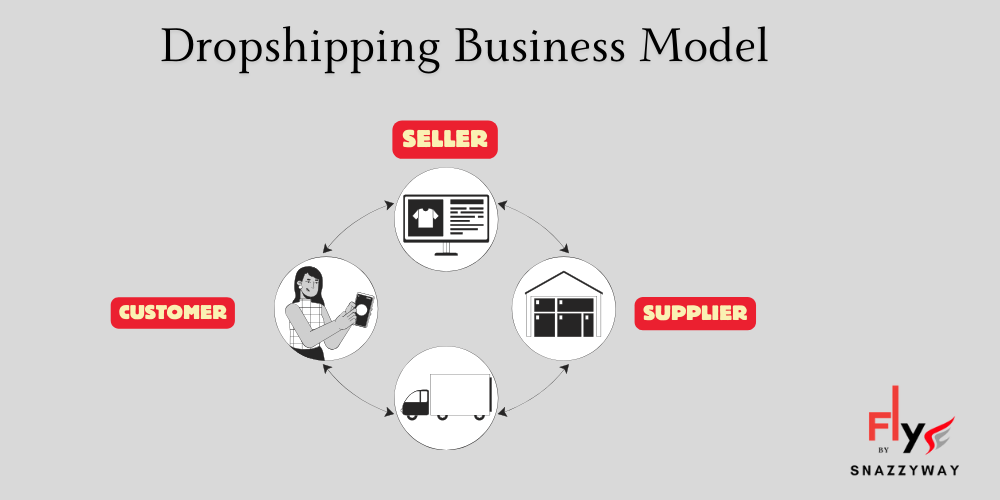Introduction to Dropshipping
Module 1: Introduction to Dropshipping
1.1 What is Dropshipping?
1.2 Advantages and Disadvantages of Dropshipping in 2024
1.3 How Dropshipping Differs from Traditional Retail Models
1.4 Current Trends and Opportunities in the Dropshipping Industry
Dropshipping is a new way to do business in e-commerce that is becoming more and more common. It changes how goods are sold and shipped to customers, giving entrepreneurs and would-be business owners a chance to start their own online retail businesses with low costs and risks up front.
So, whether you're a new business owner looking into e-commerce or a business owner who wants to find new ways to make money, join us on this exciting journey as we dive into the world of dropshipping and find the keys to success in the changing world of 2023. Let's talk about what dropshipping is, how it works, and what it can do for you.
What is Dropshipping?
With dropshipping, a retailer can fulfill orders without stocking the items themselves. When a store uses the dropshipping model, it orders the product from a manufacturer or wholesaler and then has it shipped directly to the customer. The retailer acts as a middleman, facilitating the transaction between the supplier and the customer without physically handling the product.
Here's how the dropshipping process typically works:
-
Customer Places an Order: A shopper visits the retailer's online store and places an order for a product.
-
Retailer Forwards the Order: The store places the order with the supplier, who ships the product straight to the buyer.
-
Customer Receives the Product: The customer receives the product at their specified delivery address.
Advantages and Disadvantages of Dropshipping in 2024
Understanding the benefits and drawbacks of dropshipping can help businesses make informed judgments about whether it is the best fit for their business goals. Let's look at the benefits and drawbacks of dropshipping in 2024:
Advantages of Dropshipping:
Low Startup Costs:
Dropshipping removes the requirement for an initial investment in stock, storage space, and a distribution network. This means that start-up costs for an online shop can be kept to a bare minimum.
Flexibility and Location Independence:
With dropshipping, all you need to operate your business is access to the internet. Entrepreneurs can now work from anywhere, either on the go or from the comfort of their own homes.
Wide Product Range:
Dropshipping enables retailers to offer a broad range of products without needing to purchase and store them. This variety allows you to test different niches and cater to diverse customer preferences.
Scalability:
When compared to traditional retail, dropshipping businesses are easier to scale. Growing demand allows you to add new vendors and additional products to your catalog without worrying about storage space.
Less Overhead:
Dropshipping helps businesses save money by eliminating expenses like storage and labor that come with maintaining a warehouse and managing stock.
Disadvantages of Dropshipping:
Lower Profit Margins:
Because you purchase goods at wholesale costs and resell them at retail prices, your profit margins as a dropshipper will often be smaller than those of a traditional retailer.
Dependency on Suppliers:
You rely on your dropshipping suppliers for timely deliveries of high-quality goods. The satisfaction and loyalty of your customers are vulnerable to even one untrustworthy vendor.
Inventory and Product Quality Control:
Since you don't manage the stock personally, you run the risk of experiencing shortages or lower-quality goods than you bargained for.
Shipping Challenges:
Depending on the supplier's location and delivery methods, shipment durations and costs can vary, which can have an impact on consumer happiness and loyalty.
Competition and Market Saturation:
The rise in popularity of dropshipping has increased competition and may have already saturated some specialized markets.
Brand Building Challenges:
Customers may discover the identical products at multiple merchants, making it harder to establish a unique brand identity if you don't produce the goods yourself.
In spite of these obstacles, many entrepreneurs in 2024 still find dropshipping to be a fruitful and worthwhile business strategy. In order to thrive in the cutthroat world of dropshipping, it's important to work with suppliers you can trust, offer stellar support to your customers, and execute innovative marketing methods.
How Dropshipping Differs from Traditional Retail Models
Dropshipping and standard retail models are very different in how they deal with inventory, shipping, and running the business as a whole. Here are the main differences between dropshipping and regular retail:
1. Inventory Management:
-
Dropshipping: The store does not keep any inventory while using dropshipping. When a consumer puts an order, the retailer acquires the item from a third-party supplier, who then ships it directly to the customer. This means that the retailer never touches or owns the physical goods.
-
Traditional Retail: Traditional retail involves purchasing things in bulk from manufacturers or wholesalers and storing them in a physical location (for example, a store or warehouse). The retailer is in charge of inventory management and organization.
2. Upfront Investment:
-
Dropshipping: When compared to brick-and-mortar stores, the startup costs for a dropshipping business are much lower. Because the store doesn't have to buy things in advance, there are no storage fees.
-
Traditional Retail: Traditional retail frequently necessitates a considerable upfront expenditure in order to purchase products and establish a physical store or warehouse. This investment can be significant, particularly for larger retailers.
3. Order Fulfillment:
-
Dropshipping: With drop shipping, the vendor is responsible for fulfilling customer orders. If a consumer placed an order, the manufacturer must immediately begin processing and sending the product.
-
Traditional Retail: The customer never has to worry about their order being fulfilled because the store handles everything themselves. This entails retrieving items from storage, placing them in shipping containers, and coordinating delivery or collection.
4. Product Variety:
-
Dropshipping: With dropshipping, an online company can provide a broader selection of products since it can work with more suppliers. This allows for greater adaptability to meet the varying requirements of a wide range of customers.
-
Traditional Retail: Because of space constraints, the selection of products available at brick-and-mortar stores may be smaller than at online retailers. Merchants have to pick and choose what to stock based on demand and available shelf space.
5. Location Independence:
-
Dropshipping: With drop shipping, store owners may manage their operations from any location with access to the internet. There is no requirement for a brick-and-mortar shop or warehouse, providing freedom of movement.
-
Traditional Retail: A physical storefront is required to conduct business in the brick-and-mortar retail industry. Traditional stores' performance is primarily dependent on their location and the amount of people who frequent them.
6. Control over Product Quality and Shipping:
-
Dropshipping: The shop has less direct control over product quality and shipment delays because they do not handle the merchandise. Suppliers are in charge of these factors.
-
Traditional Retail: In conventional retail, the retailer has greater control over product quality and can directly supervise the shipping process to guarantee customers receive their orders on time.
There are benefits and drawbacks to both dropshipping and more traditional retail models, and the decision ultimately comes down to the business owner's unique objectives, resources, and tastes. Traditional retail offers more control over inventory and brand experience, while dropshipping makes getting started in business easier with fewer startup expenses.
Current Trends and Opportunities in the Dropshipping Industry
As of the year 2024, new opportunities and trends are shaping the dropshipping sector. Dropshippers can maintain competitiveness and identify expansion opportunities by keeping up with these trends. Some current developments and promising prospects in the dropshipping sector are as follows:
1.Niche Market Expansion:
Dropshippers are looking into micro dropshipping niches and specialized markets in order to target specific client segments with personalized product offerings.
2. Hyper-Personalization:
Personalization has emerged as an important feature of e-commerce. Dropshippers are using data analytics and insights into user behavior to provide personalized product suggestions, targeted marketing campaigns, and personalised shopping experiences.
3. Print-on-Demand Services:
Print-on-demand dropshipping allows shops to provide personalized products like shirts, mugs, and phone cases without holding inventory. This trend enables for greater product customization and inventiveness.
4. Influencer Marketing:
In the dropshipping sector, influencer marketing is still a powerful tactic. Collaboration with appropriate influencers and content providers can greatly increase brand awareness and sales.
5. Augmented Reality (AR) and Virtual Try-Ons:
Integrating AR technology into dropshipping stores allows customers to virtually try on products, such as clothing and accessories, before making a purchase. This enhances the online shopping experience and reduces the likelihood of returns.
6. Multi-Channel Selling:
Dropshippers are expanding their sales outlets outside of their own internet sites. Selling on marketplaces such as Amazon, eBay, and social media platforms allows them to broaden their reach and attract a larger consumer base.
7. AI and Automation:
Automation and AI are being used to simplify several facets of dropshipping, including order fulfillment, customer service, and advertising. As a result, productivity may increase while expenses decrease.
8. Subscription-Based Models:
Subscription-based business models are being adopted by several dropshippers to increase customer loyalty and repeat sales through the provision of predictable product deliveries and exclusive privileges.
Dropshippers can thrive in the increasingly competitive e-commerce market through 2023 and beyond by keeping up with these trends and capitalizing on related possibilities.











